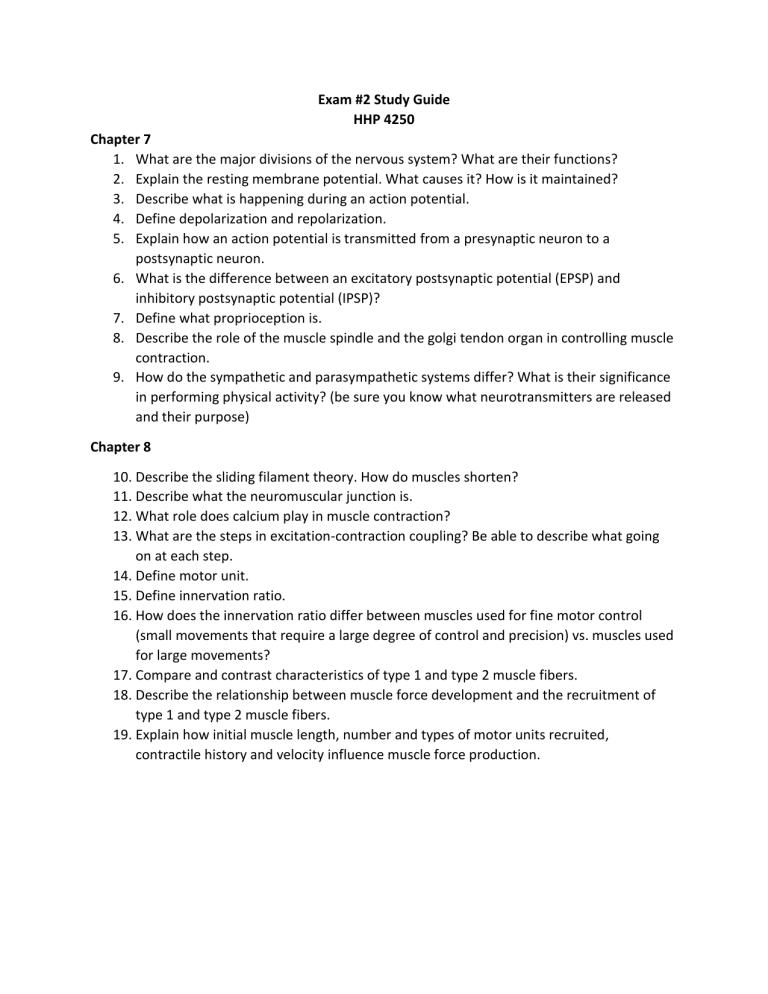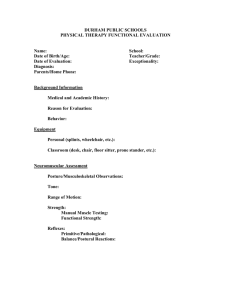
Exam #2 Study Guide HHP 4250 Chapter 7 1. What are the major divisions of the nervous system? What are their functions? 2. Explain the resting membrane potential. What causes it? How is it maintained? 3. Describe what is happening during an action potential. 4. Define depolarization and repolarization. 5. Explain how an action potential is transmitted from a presynaptic neuron to a postsynaptic neuron. 6. What is the difference between an excitatory postsynaptic potential (EPSP) and inhibitory postsynaptic potential (IPSP)? 7. Define what proprioception is. 8. Describe the role of the muscle spindle and the golgi tendon organ in controlling muscle contraction. 9. How do the sympathetic and parasympathetic systems differ? What is their significance in performing physical activity? (be sure you know what neurotransmitters are released and their purpose) Chapter 8 10. Describe the sliding filament theory. How do muscles shorten? 11. Describe what the neuromuscular junction is. 12. What role does calcium play in muscle contraction? 13. What are the steps in excitation-contraction coupling? Be able to describe what going on at each step. 14. Define motor unit. 15. Define innervation ratio. 16. How does the innervation ratio differ between muscles used for fine motor control (small movements that require a large degree of control and precision) vs. muscles used for large movements? 17. Compare and contrast characteristics of type 1 and type 2 muscle fibers. 18. Describe the relationship between muscle force development and the recruitment of type 1 and type 2 muscle fibers. 19. Explain how initial muscle length, number and types of motor units recruited, contractile history and velocity influence muscle force production. Chapter 9 20. Describe the organization/anatomy of the cardiovascular system (pulmonary circuit vs. systemic circuit) 21. Describe the conduction of electrical activity of the heart (think about how the electrical signal is carried through the heart) 22. Looking at an ECG, describe what the major events that are occurring (What is happening at the p wave, QRS complex and t wave?) 23. Define cardiac output. How is it calculated? How is cardiac output increased? 24. Define stroke volume, systolic blood pressure, diastolic blood pressure, end-diastolic volume (EDV). 25. What factors regulate HR during exercise? Stroke volume? 26. At the onset of exercise, what causes the initial increase in heart rate? 27. Describe the pattern of redistribution of blood flow during exercise. 28. Describe the changes that occur in HR, SV and cardiac output during prolonged exercise and incremental exercise 29. Describe the 3 mechanisms for returning blood back to the heart during exercise (venous return). How does exercise influence venous return? 30. Define the Frank-Starling mechanism. How does this work during exercise? 31. How does blood pressure respond to exercise?




